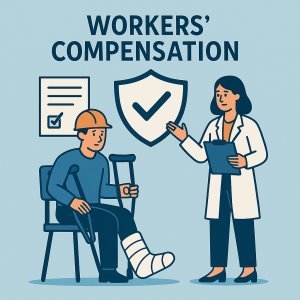
Multi-State Workers’ Comp Compliance for National Senior Care Providers
July 28, 2025Co-Employment Workers’ Comp Insurance Georgia Guide
July 29, 2025In today’s complex healthcare environment, nursing home administrators face a multitude of operational and financial challenges. Among these is teh critical decision of how to manage insurance coverage effectively-especially when it comes to general liability and workers’ compensation policies. Bundling these coverages into a single package is often presented as a cost-saving and administratively convenient option. However, the potential benefits must be carefully weighed against the risks and limitations inherent in combining these distinct types of insurance. This article explores the strategic considerations nursing homes should evaluate when deciding weather bundling general liability and workers’ comp is a smart move or a risky proposition.
Table of Contents
- Advantages of Bundling General Liability and Workers’ Compensation for Nursing Homes
- Potential Risks and Coverage Gaps to Consider Before Bundling
- Key Factors Influencing Cost Savings and risk Management Effectiveness
- Best Practices for Selecting and Managing Bundled Insurance Policies in Nursing Homes
- Q&A
- To Wrap It Up
advantages of Bundling General liability and Workers’ Compensation for Nursing Homes
Enhanced Risk Management and Comprehensive Coverage: Bundling encourages insurers to adopt a more holistic approach to risk assessment by understanding the full scope of workplace and liability risks. this integrated view often results in tailored coverage options that address the unique challenges faced by nursing homes, such as resident injuries and employee accidents, under one policy umbrella. Additionally, bundled policies typically come with centralized claims handling, which can expedite resolutions and reduce coverage gaps, ensuring both residents and staff are adequately protected.
potential Risks and Coverage Gaps to Consider Before Bundling
While bundling general liability and workers’ compensation insurance may seem cost-effective, it comes with certain risks that nursing homes must evaluate carefully. One primary concern is the potential coverage gaps that can occur when policies are combined without thorough customization. Such as, bundled packages might not fully address specific nursing home exposures such as patient abuse claims or unique state-mandated workers’ comp provisions. Additionally, ambiguity in policy language when policies are merged can lead to disputes during claims processing, ultimately delaying critical financial support.
Administrators should also be aware of the possible impact on claims handling and adaptability.Bundled policies often come with uniform terms that limit options to tailor coverage for varying risk profiles within the facility. Furthermore, a single bundled policy might result in a higher deductible or aggregate limits that do not align with the actual risk, placing undue financial strain if multiple claims arise together. Nursing homes should weigh these considerations against cost benefits and possibly consult with risk management professionals to ensure comprehensive protection.
Key Factors Influencing Cost Savings and Risk Management effectiveness
cost savings when bundling general liability and workers’ compensation insurance for nursing homes hinge significantly on the scale of the operation and past claims data. Larger facilities with lower incident rates often benefit from volume discounts and negotiated premium reductions. However, smaller nursing homes might encounter less flexibility in pricing, making the upfront savings less pronounced. Additionally, the level of coverage customization allowed within a bundled policy can directly impact cost efficiency. Providers offering tailored packages that align closely with the specific risk profiles of nursing homes tend to deliver better value than generic bundles.
on the risk management side, effectiveness depends on the insurer’s expertise in healthcare-specific liabilities and workplace injuries common in nursing home settings. Bundling policies through a carrier well-versed in both liability and workers’ comp creates a unified approach to claims handling and preventive strategies. This integrated approach fosters stronger communication channels and quicker resolution of incidents, reducing administrative overhead and the likelihood of overlapping coverage gaps.
| Factor | Impact on Cost Savings | Impact on Risk Management |
|---|---|---|
| facility Size | Higher volume discounts | More complex risk profile |
| Claims History | Better rate stability | Focused prevention programs |
| Coverage Customization | Reduces wasteful spending | Addresses unique risks |
| Insurer Expertise | Optimized pricing models | Effective claim management |
- Transparent underwriting processes ensure nursing homes understand what impacts their premiums and coverage.
- Proactive safety training programs embedded in bundled policies help lower workplace injury rates specifically tailored to nursing home environments.
- Claim integration between general liability and workers’ comp reduces administrative duplication and can speed up settlements.
Best Practices for Selecting and Managing bundled Insurance Policies in Nursing Homes
To effectively manage bundled policies, foster regular communication between your insurance broker and internal risk management team. This collaboration helps keep coverage aligned with operational realities and mitigates the risk of overlooked claims or underinsurance. Consider implementing a simple tracking system like the one below to monitor renewal dates, claim histories, and premium changes across both policy types. This proactive approach not only safeguards your facility but also maximizes cost-efficiency in the long run.
| Key Metric | General Liability | Workers’ Comp |
|---|---|---|
| renewal Date | Annual (May 15) | Annual (May 15) |
| Claims Last Year | 3 | 5 |
| Premium Trend | +2% | +4% |
| Policy Notes | No flood coverage | Covers temp workers |
Q&A
Q&A: Bundling General Liability and Workers’ Comp for Nursing Homes – Smart or Risky?
Q1: What does bundling General Liability and Workers’ Compensation insurance mean for nursing homes?
A1: Bundling refers to the practice of purchasing general Liability (GL) and Workers’ Compensation (WC) insurance policies together, often from the same insurer or as part of a single package. For nursing homes, this means consolidating coverage for both third-party claims (such as visitor injuries) and employee-related workplace injuries under one umbrella.
Q2: What are the potential advantages of bundling these policies?
A2: Bundling can simplify administrative processes by reducing the number of insurers and points of contact. It can also lead to cost savings through package discounts or streamlined underwriting. Furthermore, a bundled policy may provide broader coverage coordination, perhaps minimizing coverage gaps.Q3: What are the key risks or downsides associated with bundling GL and WC insurance?
A3: One risk is reduced flexibility; nursing homes might be locked into terms or coverage limits that don’t ideally meet their needs across both lines. Bundling can also obscure true cost comparisons between insurers, making it harder to identify the best value. Additionally, if one policy experiences claims issues, it can impact negotiations or renewal terms for the bundled package.
Q4: How can bundling impact claims handling and risk management for nursing homes?
A4: A single insurer handling both policies may improve claims coordination, leading to faster resolutions. Conversely, if the insurer lacks expertise in either GL or WC claims specific to nursing homes, it could result in suboptimal claim outcomes. It’s crucial to ensure that the bundled policy is supported by an insurer with strong capabilities in both areas.
Q5: Are there industry-specific considerations nursing homes should keep in mind when deciding to bundle?
A5: yes. Nursing homes face unique risks including resident care liabilities and employee injury exposures. The bundled policy should address these nuances thoroughly. It’s essential to evaluate whether bundling compromises tailored coverage or endorsement flexibility that might be necessary for regulatory compliance and risk profiles in the long-term care sector.
Q6: What steps should nursing home administrators take before deciding to bundle these insurance policies?
A6: administrators should conduct a comprehensive risk assessment and cost-benefit analysis, comparing bundled versus separate policies.Consulting with insurance brokers or risk management professionals who understand the healthcare sector is advisable. Thoroughly reviewing policy terms, exclusions, and insurer reputation for claims service is also critical.
Q7: is bundling General Liability and Workers’ Compensation insurance a smart or risky decision for nursing homes?
A7: Bundling can be a smart choice when it leads to streamlined administration, cost efficiencies, and cohesive coverage; however, it carries risks if it reduces coverage flexibility or integrates policies from insurers lacking domain expertise. the decision should be based on careful evaluation of the nursing home’s specific risk profile, coverage needs, and insurer capabilities.
To Wrap It Up
bundling general liability and workers’ compensation insurance for nursing homes presents both strategic advantages and potential pitfalls. While combining these coverages can streamline administration and potentially reduce costs, it is essential for nursing home operators to carefully assess their unique risk profiles and operational needs.Engaging with experienced insurance professionals to tailor bundled policies ensures that coverage gaps are minimized and compliance standards are met. Ultimately, a thoughtful approach to insurance bundling can support financial stability and risk management, fostering a safer and more resilient environment for both residents and staff.
“This content was generated with the assistance of artificial intelligence. While we strive for accuracy, AI-generated content may not always reflect the most current information or professional advice. Users are encouraged to independently verify critical information and, where appropriate, consult with qualified professionals, lawyers, state statutes and regulations & NCCI rules & manuals before making decisions based on this content.






